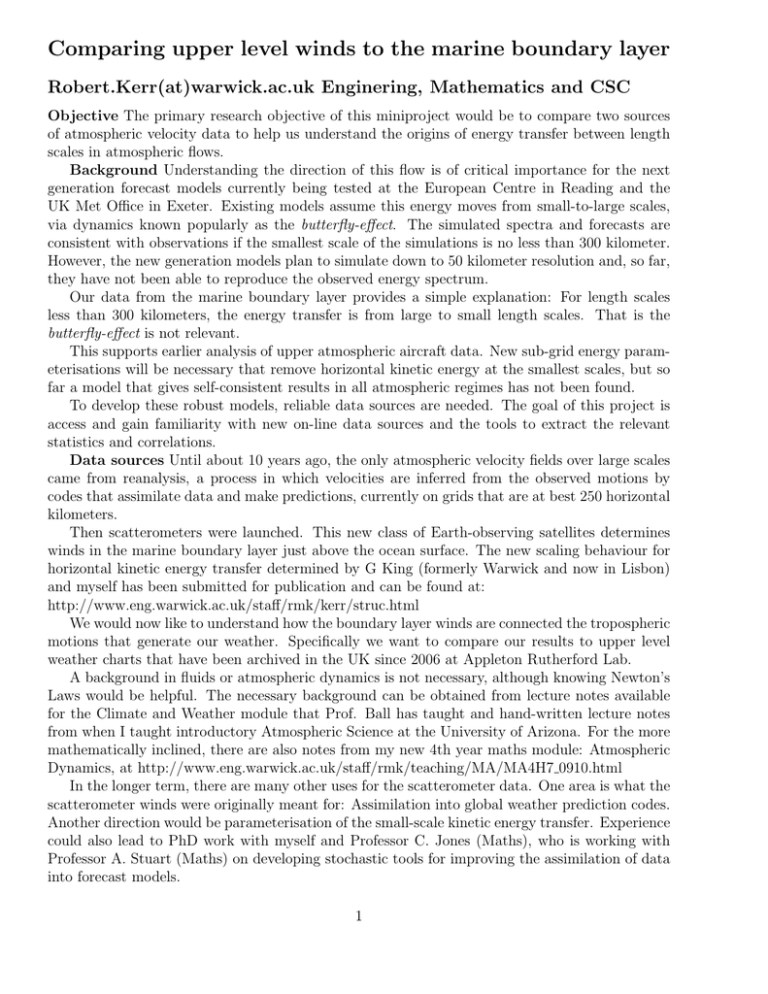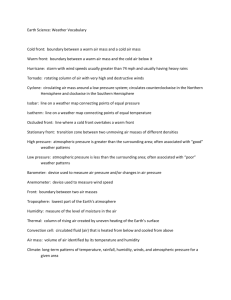Comparing upper level winds to the marine boundary layer
advertisement

Comparing upper level winds to the marine boundary layer Robert.Kerr(at)warwick.ac.uk Enginering, Mathematics and CSC Objective The primary research objective of this miniproject would be to compare two sources of atmospheric velocity data to help us understand the origins of energy transfer between length scales in atmospheric flows. Background Understanding the direction of this flow is of critical importance for the next generation forecast models currently being tested at the European Centre in Reading and the UK Met Office in Exeter. Existing models assume this energy moves from small-to-large scales, via dynamics known popularly as the butterfly-effect. The simulated spectra and forecasts are consistent with observations if the smallest scale of the simulations is no less than 300 kilometer. However, the new generation models plan to simulate down to 50 kilometer resolution and, so far, they have not been able to reproduce the observed energy spectrum. Our data from the marine boundary layer provides a simple explanation: For length scales less than 300 kilometers, the energy transfer is from large to small length scales. That is the butterfly-effect is not relevant. This supports earlier analysis of upper atmospheric aircraft data. New sub-grid energy parameterisations will be necessary that remove horizontal kinetic energy at the smallest scales, but so far a model that gives self-consistent results in all atmospheric regimes has not been found. To develop these robust models, reliable data sources are needed. The goal of this project is access and gain familiarity with new on-line data sources and the tools to extract the relevant statistics and correlations. Data sources Until about 10 years ago, the only atmospheric velocity fields over large scales came from reanalysis, a process in which velocities are inferred from the observed motions by codes that assimilate data and make predictions, currently on grids that are at best 250 horizontal kilometers. Then scatterometers were launched. This new class of Earth-observing satellites determines winds in the marine boundary layer just above the ocean surface. The new scaling behaviour for horizontal kinetic energy transfer determined by G King (formerly Warwick and now in Lisbon) and myself has been submitted for publication and can be found at: http://www.eng.warwick.ac.uk/staff/rmk/kerr/struc.html We would now like to understand how the boundary layer winds are connected the tropospheric motions that generate our weather. Specifically we want to compare our results to upper level weather charts that have been archived in the UK since 2006 at Appleton Rutherford Lab. A background in fluids or atmospheric dynamics is not necessary, although knowing Newton’s Laws would be helpful. The necessary background can be obtained from lecture notes available for the Climate and Weather module that Prof. Ball has taught and hand-written lecture notes from when I taught introductory Atmospheric Science at the University of Arizona. For the more mathematically inclined, there are also notes from my new 4th year maths module: Atmospheric Dynamics, at http://www.eng.warwick.ac.uk/staff/rmk/teaching/MA/MA4H7 0910.html In the longer term, there are many other uses for the scatterometer data. One area is what the scatterometer winds were originally meant for: Assimilation into global weather prediction codes. Another direction would be parameterisation of the small-scale kinetic energy transfer. Experience could also lead to PhD work with myself and Professor C. Jones (Maths), who is working with Professor A. Stuart (Maths) on developing stochastic tools for improving the assimilation of data into forecast models. 1





